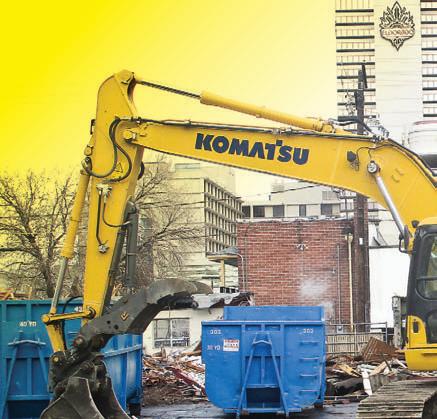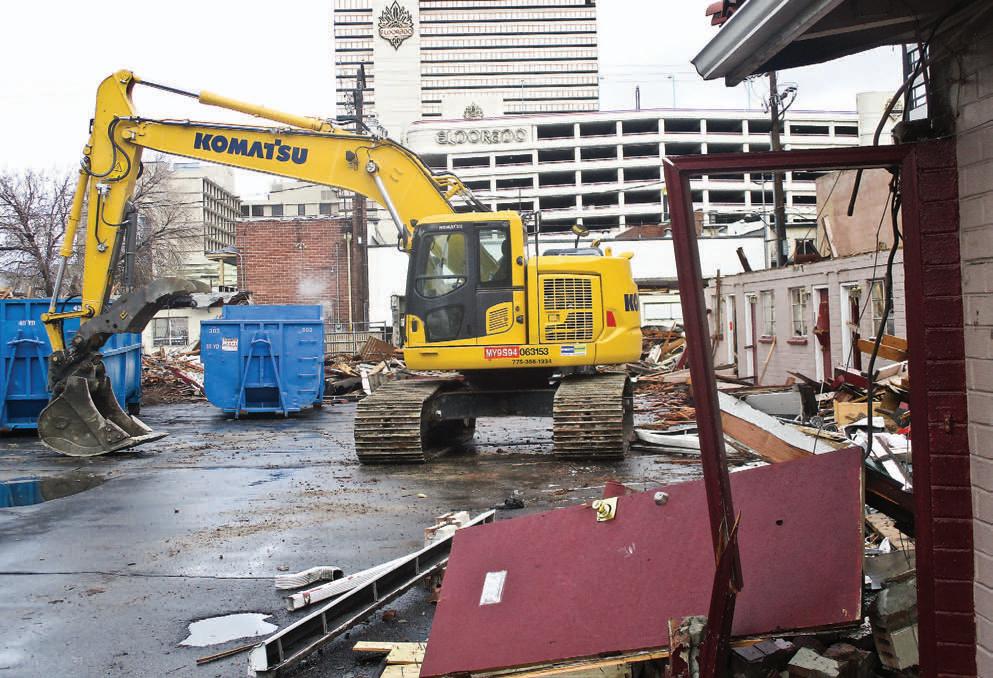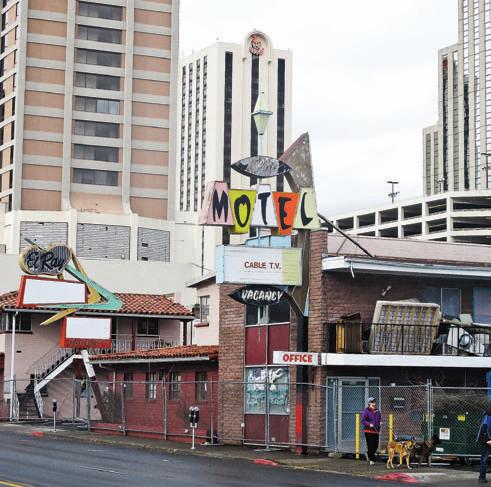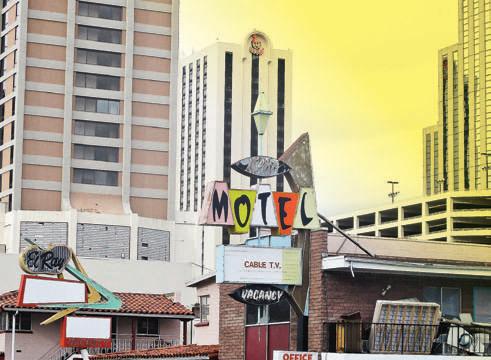
15 minute read
FEatURE
from April 5, 2018


Advertisement
story and photos by DEnniS MyERS
SEcRET planS
The El Ray Motel, in pieces.
Once word got around, and more and more plots of land were acquired, there was increasing concern about the corporation’s intentions.
There was a time when demolition of buildings was taken as progress in Reno (“Paradise lost,” RN&R, Nov. 16, 2006), but those days were long gone. The outof-control growth of the late 1970s that wreaked havoc with quality of life in the Truckee Meadows added new sensibilities to the city, including heritage. Some residents became more interested in city government that served residents rather than tourists.
Now, a seemingly high-handed absentee corporation was treating Reno properties like chess pieces without giving the public or its representatives any sense of the big picture that was being planned for the city. The Reno Gazette Journal on March 27 reported that one businessperson, Farrah Reed, has been briefed by Jacobs on the plans that have been withheld from elected officials and the public that elected them. She declined to describe the plans.
It’s up to public officials to press for transparency, but members of the Reno City Council—Neoma Jardon and Hillary Schieve—have been found standing shoulder to shoulder with Jacobs executives at news conferences to promote their undisclosed plans, which did a good job of sending the message that the city had little interest in requiring clarity from Jacobs. It was a reminder that when Project C, which became the Silver Legacy, was announced in 1993, Mayor Pete Sferrazza angered many by being seated on the stage with CircusCircus and Eldorado representatives before the city had done its job of scrutiny.
“I’m so perplexed by Jacobs Entertainment and their refusal to reveal their exact plans,” said one activist who did not want her name used. “What could they possibly be building on all that land? And why demolish what’s there now, so far in advance of building anything? I wish city officials would ask for a clear depiction of what this ‘Fountain District’ will actually contain rather than supporting all of this demolition without question. Empty lots benefit no one, and some of these motels could be turned into appealing and viable development. It’s frustrating.”
Jacobs’ vague descriptions of its plans or lack of plans have created equally vague journalism. KTVN and the Reno Gazette Journal have described Jacobs’ plans as “mixed-use redevelopment.” The news site This is Reno characterized comments by a Jacobs publicist as “plans for the properties are not yet determined.” “While Jacobs Entertainment has not yet announced exactly what will be built … it’s all part of a bigger plan,” reported KTVN, S omething was up in Reno. For months, officials and activists kept hearing about a previously unknown Colorado mega-corporawithout saying what the bigger plan is. Contacting Jacobs’ Colorado office is just as frustrating. A menu tells a caller to punch zero for help, followed by “Sorry, the tion acquiring land to the north and west operator is not available.”of the city core. More often than not, In November, a Jacobs news release said this kind of thing is accompanied by announcements of projects, of building, of jobs. This corporation, Jacobs Entertainment, tended not to do that. “Now, here you have a very low-key land assemblage,” said City Councilmember it was planning for “a new arts and entertain ment district.” The term “Fountain District” itself became a target. “We name districts,” said one official. “They don’t.” Jenny Brekhus, who represents The corporation also seemed to try to the territory at issue. keep the northwest quadrant below the radar. For instance, there was the odd matter of the intersection of Washington and Fourth streets. There were a couple of traffic deaths at that corner, and it prompted understandable concern in official circles. It
A mysterious corporAtion becomes A reno plAyer
“SEcRET planS” continued on page 12
may have just been coincidence—
“secRet the intersection had been there for plans” continued decades without getting a reputation as hazardous. from page But Jacobs got involved and 11 convinced the city council to create a blockage so that cars can no longer cross Fourth at Washington. It was a strange “solution” to the problem, if it was a problem, and it certainly was not what Jacobs called it—a “traffic improvement.”
“Why is Jacobs interested in such a thing?” asked one official.
Perhaps because getting it resolved, at least temporarily, took some eyes off the northwest quadrant.
Some worried that Jacobs, with more than 20 acres acquired, might “combine blocks to create superblocks” or that the corporation might unveil a Las Vegas-style megaresort. Surprisingly, what turned the matter into a more public dispute was something far less elaborate—motels.
How Reno tHRived
Nevada would not have been successful in the postwar era if it had not been for motels, and no city knew that better than Reno.
In 1925, Reno was designated as the site for a 1927 Transcontinental Highway Exposition, and it was not really a good choice, though few city leaders would have admitted it. Utah and California helped out with money, but the city scrambled to find places to put visitors. Existing hotels—motels did not yet exist—could hardly handle the overflow, and camps were set up in places like Deer Park in Sparks. Just two months before the expo was scheduled to start, the exposition board and local chamber of commerce threw a whopping $35,000 at the problem ($495,152.56 in February, 2018, dollars) for a tent city to provide a thousand housing units.
The city got through that challenge, but by the time the soldiers and sailors came marching home in 1945 and ’46, the challenge was not a five-week festival but a nation that emerged from the Depression and war as mobile and prosperous, ready to travel to resort destinations with disposable income. As it happens, just seven months after Reno was given the task of staging the 1927 exposition, there had been a new development on the U.S. scene. In San Luis Obispo on Dec. 12, 1925, Milestone Mo-Tel opened. Designed by architect Arthur Heineman, it opened with two-room bungalows available for $1.25 a night. It is believed to be the first motel.
As Reno, Las Vegas and other communities thrived in the 1950s, motels were a huge part of the reason. There were hotels in Reno, but they were not adequate to the demand, not especially plush, and not always successful. Even the first postwar tourist hotel constructed, the Mapes, had chronic financial problems throughout its history and survived only with welfare from the U.S. Reconstruction Finance Corporation.
Motels blossomed like dandelions and became a part of Nevada lore. Nevadans told of movie star Lash LaRue opening a motel on the western U.S. 40 approach to Reno. In 1957, actress Jean Peters married billionaire Howard Hughes at the L & L Motel in Tonopah, Nevada, reportedly in room 33. In 1959, with a court action by motel owners to seize the receipts of a new room tax pending, the Washoe County Fair and Recreation Board spent all the money from the first quarter before the court acted. Frank Sinatra, Jr., was kidnapped from a Lake Tahoe motel in 1963. When KOLO television’s building in Reno erupted in flames in the middle of a newscast in 1977, the staff moved operations next door, into the El Rancho Motel.
There were battles over whether motels should be allowed to advertise their rates—Gov. Grant Sawyer signed a legislative ban—that became a chronic source of dispute. When the Motel 6 chain, which rented rooms for $6, opened a Reno outlet, there was a fight about whether the very name of the business violated the law.
But the motel era began to dim in the 1970s, after corporate gambling was made legal. With major new capital, huge casinohotels were built, the rooms rented at low prices—lower than similar hotels in other, non-gambling cities would charge—just to get gamblers into the buildings where casinos awaited. A few were able to adapt. The Golden Road Motel eventually evolved into the Clarion, a high-rise that is now the Atlantis Hotel-Casino. But that was not an option available to many such businesses.
During the Reagan era, when a large homeless population became a fixture of communities for the first time since the Depression, motels slowly began renting by the week to stay in business. These rates were often not acts of mercy—some residents were able to scrape together enough money each week to keep motel roofs over their heads but could not get far enough ahead to rent a real room or apartment at a more reasonable monthly rate and found themselves trapped.
Motels along Fourth Street experienced a double hex. Not only did they suffer as other motels did from the lowcost hotel rooms, but the construction through Reno of Interstate 80 drained from U.S. 40 the transcontinental traffic on which they had depended.
Motels seemed to mean something to Renoites, and the acquisition and impending demolition of them this year raised the profile of Jacobs Entertainment and its undisclosed plans.
Jacobs has made a $1.5 million affordable housing donation to the local housing authority. In its November news release, it said, “Although there are many plans in the works to bring the redevelopment goal to fruition, the company is still cognizant of pressing community needs. Jacobs Entertainment is partnering with Econo Lodge, located at 1885 S. Virginia St., to provide any previous senior residents who may have been displaced with a long-term, affordable housing solution. The five-year arrangement includes renting out 50 units to help the displaced seniors. The seniors staying at the Econo Lodge will receive amenities consisting of weekly maid service, laundry services and a pool. Earlier this month, three seniors have already moved into Econo Lodge.”


a row of three Jacobs-owned motel properties, now demolished, are in the foreground. looming over them are the kind of hotels that eclipsed them. There’s a section of Reno known in official documents as the northwest quadrant. It falls within the railroad tracks, Interstate 80, Keystone and Ralston Avenues. Whatever Jacobs is up to is happening within or just outside the quadrant. A master plan update for the area says of the quadrant, “The area is not identified as a formal district by the Downtown Action Plan, as near-term plan priorities are focused on other districts within the downtown regional center.” That telegraphed the city’s lack of interest in the area, which may have made it ideal for outside interests that did not want a lot of official attention. The quadrant had once been a familiar one to Reno families, including teens who frequented the Sparkle Car Wash, a nearby burger-and-fries drive-in, and the florist at Ralston and Fourth that provided prom corsages. In the buildings that now contain the Gold Dust West casino was a neighborhood grocery, Washoe Market, a Sprouse-Reitz store, and half a dozen other merchants. The Gold ’n’ Silver restaurant was where Reno police officers grabbed quick meals and where school teams departed in early morning for out-of-town tourneys. Shakey’s—the first chain pizza joint in Reno— Spudnuts, P&S Hardware, Keystone Owl Drug, the Starlite Bowl, and Smorgy’s were all familiar names. Deeper in the residential section of the quadrant—between Fourth and the railroad tracks, bleeding over into the next quadrant to the south, the Powning District—was another bit of history. Here, there were rooming houses where working people seeking divorces stayed during Reno’s time as a quickie divorce mecca. Celebrities and the affluent could stay at the outlying divorce ranches, but the less well-heeled came to Reno, took rooms in the rooming or boarding houses, and got jobs. When word went around that Jacobs had acquired one rooming house, it set off alarm bells for some locals. However much Jacobs wanted to keep its corporate head down, there was one acquisition that could not be done quietly—the Sands and the Gold Dust West, state-licensed casinos in a package deal. The Gold Dust West, which occupied a full city block, was a spinoff of the Gold Dust, a casino that once operated on Sierra Street in downtown Reno. Paradoxically, the Gold Dust—which aimed at tourists—did not survive, but the Gold Dust West, which attracted locals, is still operating. The quadrant does not suffer as severely from some of the urban maladies that afflict other Reno areas. It is relatively safe, and many residents work there or use businesses like the Gold ’n’ Silver. Brekhus, who represents the quadrant on the city council, says no one expected anyone
Motels to turn their attention there for major development. made nevada “When we did the downtown plan, we did not have a clear vision for this part of downtown and more or less left a success a holding spot for it to be revised at a later time,” she said. “In the meantime, Jacobs started buying up land. I am advocating that we go back to the drawing board and look into the area as we said we would. I will be asking the mayor, council and manager to start up that participatory and transparent planning process soon. There are also some perverse incentives or advantages in the code related to sewer connections that I think need to be reexamined and will be bringing that up soon as well. At minimum, someone who demolishes and displaces residents in this period of a housing crunch and possible sewer capacity shortages, should not get a favorable treatment if they are not moving on with a new project in the near term.”
Preservationists have been determined in trying to stop demolitions and call attention to the problem Jacobs has become. A group called Mid-Century Motel Team called to Jacobs’ attention specific examples in Boise, Sacramento, Denver and Austin, Texas, of motels retooled for other uses. Real estate agent Barrie Lynn filed appeals to try to stop demolitions. Some motel owners said they are declining sales offers so that lowincome people will have places to live.
ThisisReno.com noted that Chicago has an ordinance requiring weekly motels to notify residents when motels become available for sale and also inform affordable housing developers that the property is for sale. “Reno has no such ordinance,” the website pointedly reports.
There are problems with applying historic preservation to motels. Aging homes and some businesses can be upgraded and improved and put back into use. The singular design of motels does not necessarily lend itself to that kind of thing. One motel here or there may be converted to some boutique purpose, developers say, but there is a limit to how many motels can be saved.
And while many activists pointed out that motels are being torn down at a time when people are having trouble finding affordable housing in Reno, getting from A to B is not easy. Motels are privately owned, and the city is hardly in a position to acquire them and turn them into affordable housing. Jacobs did not acquire them for such a purpose. That leaves the federal government, but that kind of a project needed to be initiated long before motels were being bought up for demolition.
On the website RenoSparks.org, there is a map of the block bounded by Fourth, Arlington, Third and West streets. It shows uses for most of the buildings on the block—most of them motels—that presumably would allow them to be saved: “Apartments for young professionals and students. Long term amenities for business travelers.” “Boutique shops that feature Reno’s artist presence, outdoor culture, specialty foods, and antiques.” “The gateway to the neon district, featuring a Neon Museum opening into an active alley which recalls Reno’s rich history.”
Nowhere on the page is there a hint to how this ambitious agenda might be achieved, much less where the money for renovating an entire city block of structures would come from. It reads like a letter to Santa.
The corporation’s secrecy may not be helpful to the community, but there is no law against it. If elected officials will not bring illumination to the situation, the public will stay in the dark.
Brekhus notes that a hometown firm, the Don J Clark Group, announced with great fanfare in April 2016 that it would undertake the largest downtown Reno redevelopment project ever proposed. Named the West 2nd District, it would cost well over a billion dollars and would take a decade to build. Many details were provided. It would be a freestanding, entirely sustainable project with its own water re-processing, parks and art, and no public subsidies unless they completed the project. In June and October of 2017, Clark said its project was still on the rails.
By contrast, Brekhus said, Jacobs entered the scene quietly and undertook “very low-key, methodical acquisitions” without informing most people of their plans.
The city’s policy, she said, has long been to seek housing and employment for the downtown area, including a high pay scale for jobs there. She likes the Jacobs’ talk of “arts and entertainment” but said “I don’t know what that means component-wise.”
In another, similar community dispute, local activists in 2016 got organized to stop the University of Nevada, Reno from removing or destroying some 19th-century homes on Center Street between Eighth and Ninth streets. But the campus had been planning the project for years (“More redevelopment,” RN&R, Oct. 15, 2009). The activists waited until the last minute to try to stop it. Brekhus said that because of the limited information from Jacobs Entertainment, the current dispute is not another case of activists who waited too long, and there is merit to that. But the empty motels and the homeless people were both in place for years before Jacobs got interested in Reno—indeed, the need was much more urgent then than in this economic boom—and no one put the two together as problem and solution. Nor did the city. Only when an imminent threat to the motels appeared did activists do so. If there is an inclination to blame, it should not fall entirely on one side. Ω
Jacobs is vague about its plans














